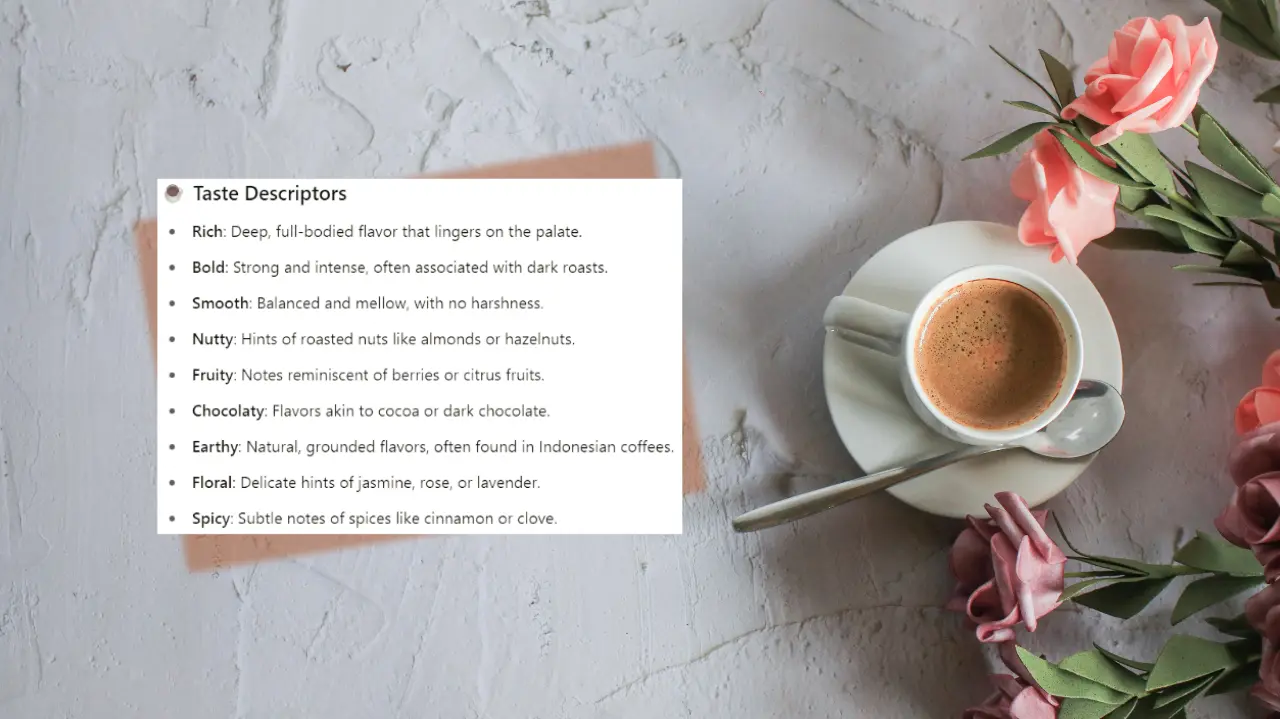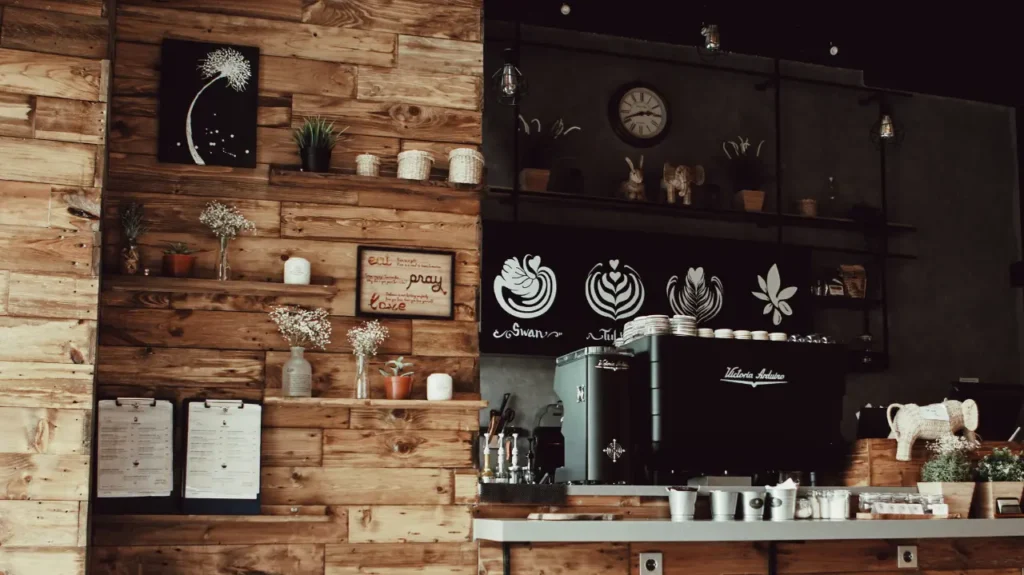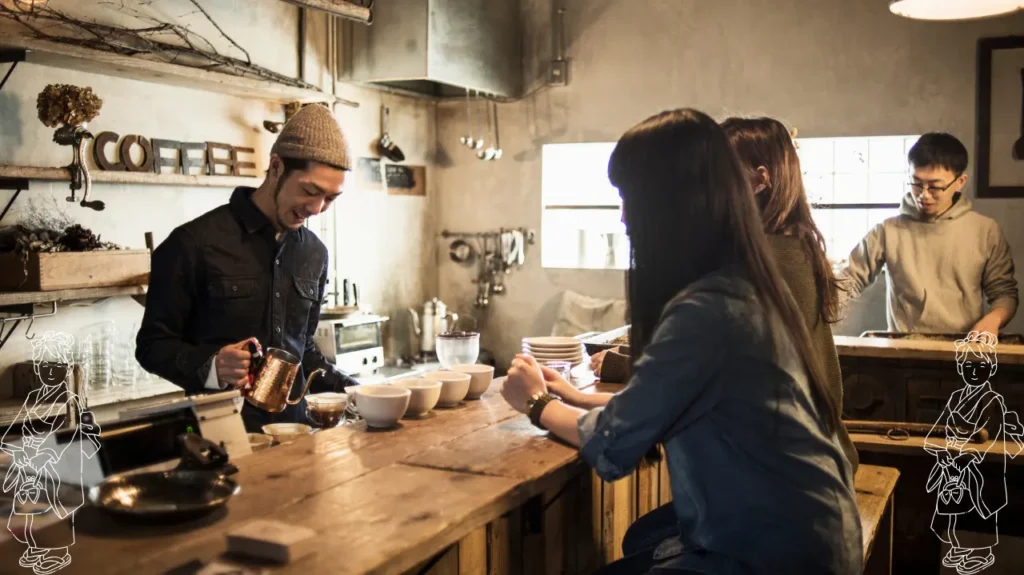Coffee isn’t just a drink; it’s a sensory journey. Every sip holds stories of far-off farms, roasting magic, and brewing artistry. But how do you put those flavors into words?
Whether you’re chatting with a barista, reviewing beans online, or simply savoring your morning ritual, words to describe coffee turn vague sips into vivid experiences.
This guide cracks the code. No jargon, no fluff. Just straightforward, practical terms anyone can use, from “bright acidity” to “velvety body.”
You’ll learn how a Colombian roast dances with caramel notes, why Ethiopian beans burst with blueberry hints, and what makes a Sumatran brew taste like earthy poetry.
We’ve blended insights from coffee experts, global brewing traditions, and everyday drinkers to create a flavor map anyone can follow.
The Importance of Describing Coffee
Have you ever tried explaining a sunset to someone who’s never seen one? That’s what describing coffee can feel like until you learn the language.
Coffee’s magic lies in its wild diversity. A single bean can taste wildly different based on where it’s grown, how it’s roasted, or even the water used to brew it.
Without the right words to describe coffee, you’re left pointing at the sky, saying, “Uh… it’s kind of brown and hot?”
Think of it this way: a coffee from Colombia might hug your tongue with caramel sweetness, while a Kenyan brew slaps it awake with citrusy zing.
If you call both “strong,” you’re missing the story. Words like “juicy acidity” or “syrupy body” aren’t just fancy labels; they’re tools that help you taste deeper.
Suddenly, you notice the apricot whisper in that pour-over or the toasted hazelnut hiding in your espresso.
For coffee pros, these words are more than poetry; they’re practical. A barista calling a blend “balanced” isn’t being vague.
They tell you it’s smooth enough for milk but bold enough to stand alone. Like a good mystery novel, roasters use “complex” to hint at layers waiting to unfold.
Even casual drinkers benefit: Ever bought a bag because the label said “chocolatey”? That’s the power of shared vocabulary.
Basic Terms to Describe Coffee
You don’t need a barista diploma to talk about coffee, just five simple ideas. Think of these as your tasting toolkit:
| Term | What It Means | Words You’ll Use |
| Acidity | The lively “sparkle” on your tongue, like citrus | Bright, crisp, zesty, smooth |
| Body | How the coffee feels, light as tea or rich as cream | Silky, creamy, velvety, thin |
| Flavor | The main event! Sweet, bitter, or specific tastes | Fruity, nutty, chocolatey, sweet |
| Aroma | The smell, often a preview of the flavor | Floral, fruity, nutty, earthy |
| Aftertaste | The memory left on your tongue after swallowing | Sweet, fruity, clean, bitter |
Here’s the kicker: these terms aren’t random poetry. They’re your cheat codes to decode what’s in your cup.
Take acidity; it’s why a light-roasted Ethiopian coffee might remind you of lemonade, while a dark Brazilian roast feels more like melted caramel.
Body explains why espresso coats your mouth like warm honey, while a pour-over might glide away like green tea.
The flavor is where the fun begins—have you ever tasted blueberries in your coffee? That’s not a fluke; it’s a signature of some Ethiopian beans.
Aroma? Sniff before sipping. That whiff of toasted almonds? It’s your nose telling your tongue what’s coming.
Advanced Descriptors and the Flavor Wheel
Think of the Coffee Taster’s Flavor Wheel as your GPS for navigating coffee’s vast flavor universe.
Developed by the Specialty Coffee Association (SCA) and World Coffee Research, this tool isn’t just for experts; it’s your cheat sheet to decode what’s happening in your cup.
Let’s break it down, layer by layer.
The Flavor Wheel
Start at the wheel’s center, where broad categories like fruity or nutty life. From there, spiral outward to pinpoint specifics.
For example, “fruity” splits into berry, citrus, or tropical fruit, and “berry” further narrows to blueberry or blackberry. This isn’t guesswork; it’s science.
The wheel uses 170 standardized terms from the SCA, ensuring everyone speaks the same coffee language, whether you’re in Tokyo or Toronto.
Taste Descriptors
Have you ever sipped a coffee that made your tongue tingle like lemon zest? That’s bright acidity. Or one that felt as smooth as caramel? That’s mellow sweetness. The wheel digs deeper:
- Sour isn’t just tart; it could be winey (think Sauvignon Blanc) or fermented (like yogurt tang).
- Sweet ranges from delicate (honey drizzle) to syrupy (maple thickness).
- Bitter isn’t always sour. Dark chocolate bitterness adds depth, while caustic bitterness hints at over-roasting.
These terms aren’t poetic fluff; they’re tied to chemical compounds. That “blueberry” note in Ethiopian coffee? It’s from the same molecules found in actual blueberries.
Aroma
Sniff before you sip. Aroma accounts for 80% of taste, and the wheel splits it into three zones:
- Enzymatic: Fresh, vibrant scents from the bean’s natural sugars, jasmine in Ethiopian Gesha, or peach in washed Colombian beans.
- Sugar Browning: Toasty, cozy notes from roasting. Think caramelized hazelnut in a medium roast or molasses in a French press brew.
- Dry Distillation: Bold, smoky whispers from darker roasts, cedar wood in Sumatran coffee, or tobacco in aged Java.
Pro tip: Compare two coffees side by side. A Kenyan AA might burst with grapefruit zest aroma, while a Brazilian Santos whispers roasted cashew.
Faults
Not all flavors are welcome. The wheel’s “faults” section is like a detective kit for quality issues:
- Earthy (wet soil)? It might mean improper drying in Sumatra, letting beans absorb ground moisture.
- Musty (mildew)? It could signal stale storage or green beans left too long in humid warehouses.
- Rubbery (burnt tires)? Often, it is a red flag for low-grade Robusta beans or over-fermentation.
These terms aren’t just critiques; they help roasters and baristas troubleshoot. A “woody” note in your espresso? Maybe the beans were roasted too fast, locking in a wet cardboard vibe.
Coffee Synonyms and Slang
Coffee isn’t just a drink; it’s a culture. And like any culture, it’s got its slang. These terms aren’t just cute nicknames; they’re insider codes that reveal how we feel about our brew.
Check out this quick guide to sounding like a coffee regular:
| Term | The Vibe | When to Drop It |
| Joe | Classic, no-nonsense American coffee | “I need my morning joe before meetings.” |
| Java | Exotic twist (thanks, Indonesia!) | “Let’s hit that new java spot downtown.” |
| Brew | Casual, any preparation | “My afternoon brew’s my productivity hack.” |
| Mud | Affectionate jab at thick, strong coffee | “This mud could power a rocket launch.” |
| Battery Acid | Playful gripe about bitter brews | “Who forgot to dilute this battery acid?” |
Here’s the fun part: these words do more than rename coffee; they set the mood. Ordering a “cup of joe” at a diner screams Americana while asking for “java” hints you’re after something adventurous.
Call your espresso “mud,” and suddenly, you’re the lovable grump who likes their coffee stout enough to stand a spoon in.
Have you ever heard a construction worker yell, “Pass the rocket fuel!”? That’s a high-octane code for coffee that is strong enough to peel paint.
Office drones might call their 3 PM pick-me-up brain juice, turning caffeine into a productivity potion.
These terms aren’t just jokes; they’re tiny stories about how we rely on (and sometimes resent) our daily grind.
Regional and Cultural Descriptions
From bustling Italian cafes to tranquil Ethiopian ceremonies, how we talk about coffee reveals who we are. Let’s travel the world through its cups.
Italy
In Italy, coffee is less about what you drink and more about how you drink it. Order a “caffè” at the bar, and you’ll get a single shot of espresso, dark, intense, and gone in three sips.
Italians don’t say “espresso”; it’s just caffè. Ask for a “macchiato,” and you’re requesting a “stained” espresso with a dollop of steamed milk, a midday treat, never a morning staple.
The lingo here is strict. Order a cappuccino after 11 AM, and you might get a side-eye; it’s a breakfast drink.
Terms like “ristretto” (a super-concentrated shot) or “lungo” (a longer pull) aren’t just menu items; they’re badges of connoisseurship.
Coffee isn’t sipped lazily; it’s a quick ritual, often enjoyed standing at a marble counter, where the barista knows regulars by name.
Ethiopia
In Ethiopia, coffee is a ceremony, not a grab-and-go habit. The Buna ritual can last hours, involving roasting green beans over an open flame, grinding them with a mortar and pestle, and brewing in a clay jebena.
The aroma of fresh-roasted beans, often described as “blueberry-like” or “floral,” fills the room, inviting guests to slow down and connect.
Ethiopians don’t just taste coffee; they experience it. The first round, Abol, is the strongest, symbolizing life’s intensity.
The second, Tona, is milder, representing balance. The final, Baraka, is a blessing, a light brew shared with laughter and stories.
Flavors here are tied to the land: Sidamo beans might taste of jasmine and lemon, while Yirgacheffe whispers of bergamot and honey.
Scandinavia
In Sweden, “Fika” isn’t a coffee break; it’s a state of mind. This daily pause pairs coffee with cinnamon buns or cardamom bread, but the focus isn’t on the brew itself.
It’s about hygge, the Danish concept of cozy togetherness. Descriptions lean toward comfort: “mellow,” “smooth,” or “like a warm blanket.”
Norway takes it further with Kaffeslabberas, a marathon coffee session with friends, where the pot is refilled until conversations run dry.
Here, coffee is rarely described as “bold” or “complex”; it’s a humble companion, often brewed light and paired with krumkake (wafer cookies).
The social ritual outweighs the tasting notes, making every cup a reminder of community.
United States
America’s coffee vocabulary is a tale of two extremes. Diners serve “joe,” thin, bottomless drip coffee described as “nutty” or “earthy,” often paired with pie.
Then there’s the third-wave scene, where “cold brew” isn’t just iced coffee; it’s a 16-hour steeped elixir with “chocolate undertones” and “bright acidity.”
Regional slang reveals priorities. In the Pacific Northwest, “single-origin” rules, with baristas waxing poetic about Guatemalan beans’ “caramel sweetness” or Ethiopian lots’ “raspberry zing.”
Down South, “sweet tea coffee” (iced coffee with condensed milk) blends tradition with rebellion. Even the humble “drip” gets rebranded as “pour-over” in Brooklyn cafes, where each cup is a sermon on terroir and roast curves.
Practical Tips for Describing Coffee
Think of it like learning a new language. Start simple, stay curious, and let your senses lead. Here’s how to turn every sip into a story.
1. Play the Five-Question Game with Every Cup
Before diving into fancy terms, ask: Is it bright or mellow? Thick or thin? Sweet or earthy? What’s the smell? Does the flavor stick around?
These five basics, acidity, body, flavor, aroma, aftertaste, are your compass.
For example, a Kenyan pour-over might hit your tongue with a citrusy zing (high acidity), feel juicy (medium body), and leave a black tea-like finish.
A Brazilian dark roast? Maybe molasses sweetness with a velvety texture and roasted almond aftertaste. Jot these down, even messy notes help train your brain.
2. Let the Flavor Wheel Be Your Cheat Sheet
The Coffee Taster’s Flavor Wheel isn’t just a poster; it’s a treasure map. Start at the center with broad terms like fruity or nutty, then zoom outward.
If you smell something floral, ask: Is it jasmine or lavender? Taste berries? Blueberry or raspberry?
Pro tip: Use it backward. If your coffee reminds you of dark chocolate, trace the wheel inward: sweet → cocoa → dark chocolate.
This “reverse engineering” helps pinpoint specifics, turning vague hunches into precise words to describe coffee.
3. Keep a “Coffee Diary” (Yes, Seriously)
Grab a notebook. Write the roast date, origin, and brew method. Then, scribble first impressions: “Ethiopian Yirgacheffe, light roast.
It smells like apricot jam. First sip: tart lemon, then honey. Finish: green tea.”
Over time, patterns emerge. You’ll notice Guatemalan beans often taste caramelly, while Sumatrans lean earthy.
This isn’t just for geeks; it’s how pros like Counter Culture’s team catalog flavors before printing tasting notes.
4. Host a Coffee Face-Off
Taste two coffees side by side. Try a bright Ethiopian vs. a chocolatey Colombian. Ask: Which feels heavier? Which has more citrus?
Comparing extremes trains your palate faster than solo sips.
This works with brewing methods, too. Brew the same beans as espresso and French press. Notice how espresso highlights dark cherry notes while the press emphasizes cocoa.
It’s like hearing the same song played on piano vs. guitar, same source, different vibes.
5. Sneak into a Cupping Session (Or Fake One)
Professional cuppings are like coffee speed-dating: slurp, spit, repeat. But you don’t need a lab coat. At home, grind four coffees, steep them in bowls, and taste unthinkingly.
Focus on contrasts: Which one’s fruitiest? Which feels like sipping silk?
Key move: Slurp loudly. It sprays coffee across your palate, waking up every taste bud. You’ll catch subtleties, like how a Honduran coffee’s vanilla note pops when aerated.
6. Steal Words from Your Kitchen
Struggling to describe that aftertaste? Raid your pantry. Sniff cinnamon, bite a dark chocolate square, or crush fresh basil. Then, taste your coffee again.
Does the finish remind you of cocoa powder or burnt toast?
This “flavor cross-training” builds mental connections. As Clive Coffee suggests, pairing coffee with foods listed on the bag (e.g., blueberries with an Ethiopian blend) makes abstract terms tangible.
You can even experiment with adding brown sugar to highlight certain sweetness notes.
7. Embrace the “It’s Just Coffee” Mindset
Not every cup needs a dissertation. Some days, it’s okay to say, “This tastes like my childhood campfire,” or “Nope, too bitter.” The goal isn’t perfection; it’s joy.
Even experts get stumped. Pull & Pour’s guide admits that tasting notes can feel like marketing fluff. Trust your gut.
If a Costa Rican coffee screams brown sugar to you but maple to your friend, both are right. Coffee’s magic lies in its subjectivity.
Conclusion
That first sip that once left you speechless? Now, you hold the words. Whether it’s calling out a coffee’s “honeyed sweetness” or playfully dubbing your espresso “rocket fuel,” every term you’ve learned is a brushstroke to paint your coffee journey.
The Flavor Wheel isn’t just a chart; it’s a translator for the bean’s whispers. Cultural terms aren’t trivia; they’re bridges to worlds where coffee is ceremony, comfort, or craft.
And those slang words? They’re inside jokes shared with millions of caffeine lovers, past and present.
So next time you brew, remember: describing coffee isn’t about being “right.”
It’s about turning your cup into a canvas, where “bright acidity” becomes a sunrise, and “earthy depth” feels like forest soil underfoot.
Whether you’re sharing coffee quotes on Instagram or simply savoring a quiet moment with your favorite blend, these words transform every sip from a simple drink into a rich, sensory story waiting to be told.




